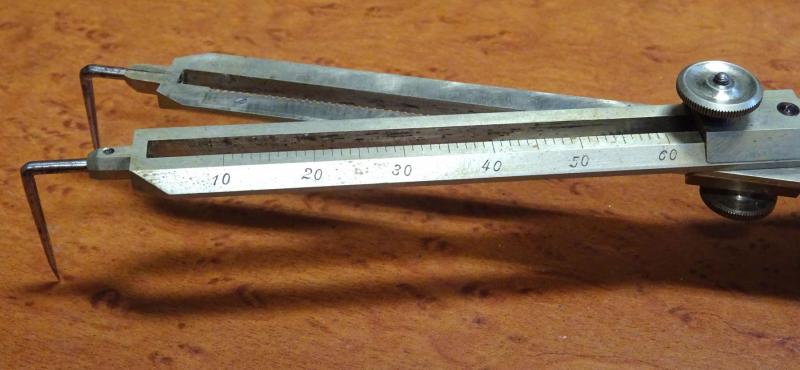-
Posts
13,298 -
Joined
-
Last visited
Content Type
Profiles
Forums
Gallery
Events
Everything posted by druxey
-
But do it you did, and very neatly, Mike. Nice!
- 452 replies
-
- cheerful
- Syren Ship Model Company
-
(and 1 more)
Tagged with:
-
Congratulations, Gaetan! That is one magnificent model. The puzzle pieces fit perfectly. Now please protect her in a case.
- 728 replies
-
- le fleuron
- 64 gun
-
(and 1 more)
Tagged with:
-
Nicely carved, Toni. With the tiller almost parallel to the deck, does it dip down too far toward the deck when the tiller is swung? If so, simply turn the tiller the other way up!
- 1,449 replies
-
The joints will show more through paint over time, Maurys. If they show too much when first painted, that's not a good sign!
- 525 replies
-
- anchor hoy
- hoy
-
(and 1 more)
Tagged with:
-
Mike: frequent hand-washing and cleanliness in the shop are the keys to avoiding fingerprints.
- 889 replies
-
Thank you Michael and Wefalck, for the comprehensive and logical responses to my question. I assumed that there was good reason for using round rather than square stock, but now you've convinced me! I also hadn't thought through the fact that square collets are not available at those sizes.
- 749 replies
-
- albertic
- ocean liner
-
(and 2 more)
Tagged with:
-
Stanchions look great, Michael, even at large magnification. Would it have been a possibility to start with square section stock, drill the holes and then turn, or would cutting forces have snapped the work at the holes?
- 749 replies
-
- albertic
- ocean liner
-
(and 2 more)
Tagged with:
-
It's annoying that the draughtsman didn't draw the carved works! One would be fairly safe with either a standard lion or, perhaps, a classical soldier holding a pointy sword.
- 1,126 replies
-
Wood will tone down in time, Ben. She is coming back nicely now!
- 889 replies
-
Nice progress. How difficult is it to draw nickel silver?
- 749 replies
-
- albertic
- ocean liner
-
(and 2 more)
Tagged with:
-
After cutting a few of these joints, they should be easy! That last one looks very good, Maury.
- 525 replies
-
- anchor hoy
- hoy
-
(and 1 more)
Tagged with:
-
An excellent video of advice for folks contemplating a fully framed model. You are a very honest model-maker, Kevin! I appreciate you sharing your experience with everyone.
- 1,126 replies
-

Red Paint or Red Ochre
druxey replied to davyboy's topic in Painting, finishing and weathering products and techniques
To reduce chroma (color brightness) often a small amount of the complimentary color is added. A complimentary color is one found on the opposite side of the color wheel. For instance, to reduce an orange-red a greenish blue is used. It sounds counter-intuitive, but it works! -

Swan-Class Sloop by garyb - 1:48
druxey replied to garyb's topic in - Build logs for subjects built 1751 - 1800
At least you realized this early in the game and no wood was harmed! -
Well done, Michael. I assume the meltdowns referred to the stanchions and not yourself!
- 749 replies
-
- albertic
- ocean liner
-
(and 2 more)
Tagged with:
-

Michael Mott Designed Third Hand
druxey replied to BANYAN's topic in Modeling tools and Workshop Equipment
I too was a lucky recipient of one of Michael's third hands. It's a beautiful piece of small engineering. -

Red Paint or Red Ochre
druxey replied to davyboy's topic in Painting, finishing and weathering products and techniques
There is 'red' and there is 'red'. Both Orange-red and crimson red are 'red', but mixed with white or other colors will yield very different results. -
Pleased to oblige, Wefalck. Pictures as requested. They certainly are attractive instruments. There is a table of figures for setting every conceivable proportion one might want. I use similar strategies to yourself when subdividing distances, especially on curved surfaces such as hulls.
-
I'm afraid I have to agree with Wefalck. I actually have a beautiful pair of 10" dividers - rack and pinion, 110 division scale, with right-angled tips so that you can use the instrument parallel to your work rather than held vertically - and very seldom use them.
About us
Modelshipworld - Advancing Ship Modeling through Research
SSL Secured
Your security is important for us so this Website is SSL-Secured
NRG Mailing Address
Nautical Research Guild
237 South Lincoln Street
Westmont IL, 60559-1917
Model Ship World ® and the MSW logo are Registered Trademarks, and belong to the Nautical Research Guild (United States Patent and Trademark Office: No. 6,929,264 & No. 6,929,274, registered Dec. 20, 2022)
Helpful Links
About the NRG
If you enjoy building ship models that are historically accurate as well as beautiful, then The Nautical Research Guild (NRG) is just right for you.
The Guild is a non-profit educational organization whose mission is to “Advance Ship Modeling Through Research”. We provide support to our members in their efforts to raise the quality of their model ships.
The Nautical Research Guild has published our world-renowned quarterly magazine, The Nautical Research Journal, since 1955. The pages of the Journal are full of articles by accomplished ship modelers who show you how they create those exquisite details on their models, and by maritime historians who show you the correct details to build. The Journal is available in both print and digital editions. Go to the NRG web site (www.thenrg.org) to download a complimentary digital copy of the Journal. The NRG also publishes plan sets, books and compilations of back issues of the Journal and the former Ships in Scale and Model Ship Builder magazines.




